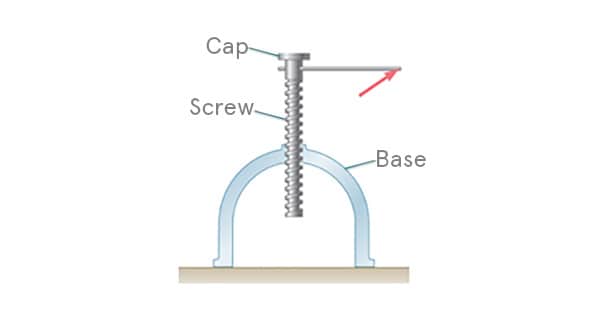Mechanical Comprehension Test Guide 2023
A mechanical comprehension test is nothing to fear. In this guide you’ll find everything you need to know to pass, from practice questions to pro tips!
In this free mechanical comprehension test guide we will show you:
- 2 techniques to solve mechanical comprehension problems
- 4 quick and easy ways to get test-ready and confident
- The best tailored preparation resources
You can find our recommended mechanical comprehension practice tests here.
What is a mechanical comprehension test?
Mechanical comprehension tests are used to assess your knowledge of mechanical and technical concepts, and how well you use those concepts to solve problems.
They’re commonly included as part of the recruitment process for jobs or graduate schemes in the engineering industry. But you could be asked to take a mechanical comprehension test for non-engineering roles, too.
These tests give employers an indication of your spatial awareness and logical thinking, which can be valuable in a range of different industries and roles.
Here’s some good news: Mechanical comprehension tests are tests of knowledge.
Unlike abstract reasoning tests, which test your judgement and potential, mechanical comprehension test questions are based on technical rules and concepts that you can learn. That means if you study and understand those rules and concepts, you can perform better on the test.
What to expect
These tests are multiple choice, and timed.
The number of questions and time limit will vary between tests and employers, but you can expect most mechanical comprehension tests to allow 30-40 seconds per question.
Topics covered in the test
The questions cover basic mechanical and physical concepts, including:
- Kinetic and potential energy
- Acceleration
- Gravity
- Friction
- Pressure
- Levers
- Pulleys
- Screws
- Gears
- Springs
- Electrical circuits
- Voltage
- Magnetism
- Tools
A typical mechanical comprehension test question will give you an image or diagram involving one of these concepts, and a question that requires you to apply that concept.
Mechanical comprehension test example questions (and answers)
Let’s take a look at a couple of example questions from Mechanical Aptitude Test.
Here’s one on the topic of screws:
The below shows a screw with following the measurements:
- 0.25 mm in overall length
- 250 revolutions
What is the pitch of the screw?
A) 1 cm
B) 1 mm
C) 10 mm
ANSWER
How to solve question 1
You would find the pitch of the screw by dividing the length of the screw by the number of revolutions.
250mm ÷ 250 revolutions = 1mm pitch
Example question 2
Try one more example question, this time on the topic of springs:
What is the force needed to move the mass 2 inches to the right as shown in this figure? Neglect friction.
A) 24 pounds
B) 34 pounds
C) 10 pounds
ANSWER
That correct answer is A.
How to solve question 2
To find the force of the spring, you would multiply the constant of the spring by the displacement.
12lb/in x 2 inches = 24 pounds
Mechanical comprehension tests video
Here is a great CareerVidz video explaining what mechanical comprehension tests are and how you pass them. Make sure to take some notes!
You can find more of their videos here and our recommended mechanical comprehension practice tests here.
How to pass a mechanical comprehension test: 4 pro tips
#1: Understand the mechanical concepts
As you can see from the example questions above, a thorough understanding of mechanical concepts and principles is key to passing the test.
If you’ve already gotten to this point in the recruitment process, you probably already have a pretty good grasp of these concepts. But if you’re feeling rusty, revise the topics we listed above and make sure you’re across all the basic principles and formulas.
The skills required to pass a mechanical comprehension test are learned, not inherent.
So, study and preparation can go a long way!
YouTube videos are a great way to brush up on the basics — check out these mechanical concepts playlists here and here.
Or, if you’re more of a textual learner, try reading technical user manuals to learn more about how mechanical concepts work in real life. Haynes is a good resource for manuals, or you can buy second-hand manuals from eBay or Gumtree.
#2: Practise, practise and practise some more
Understanding the theory is only one part of the equation. You also need to make sure you know how to apply the concepts practically to solve problems. And you can only do this by practising!
Mechanical comprehension practice tests are the obvious first step.
Take as many as you can — it’s the best way to familiarise yourself with the format, types of questions, and time restrictions.
As well as practice tests, you should also look for opportunities in your everyday life to build your knowledge and experience.
Take things apart and put them back together. Build things. Fix things. Use different tools and equipment. Be curious about how things work.
When it comes to aptitude tests, there’s no such thing as too much preparation!
#3: Focus equally on accuracy and speed
How you perform in your mechanical comprehension test depends on two things:
- How many correct answers you get, and
- How many questions you answer within the time limit.
So, speeding through the questions won’t help you — you’re more likely to misread questions and answer incorrectly.
But spending a lot of time on each question isn’t a good idea either, because you won’t be able to answer many in the given time.
The best way to find the right balance between accuracy and speed is by taking lots of practice tests and making sure you understand the concepts behind the questions.
Remember: Aim to give yourself about 30-40 seconds per question. And don’t be disheartened if you can’t finish the test (only 1-5% of people actually do).
What’s more important is to answer as many questions as you can, correctly.
#4: Calm your nerves
It’s normal to feel nervous before a test like this. But try not to let those nerves get the better of you.
Feeling anxious or flustered can result in overthinking (or underthinking) the questions, leading to more wrong answers.
Take a few deep breaths before starting the test, and be conscious of your breathing throughout the test.
Focus your full attention on the questions in front of you.
Preparing and practising as much as possible beforehand will also help a lot with calming your nerves and boosting your confidence.
Some more guides to help you succeed…
- Numerical Reasoning: Numerical Reasoning Test Guide: 5 Proven Tips to Succeed
- Verbal Reasoning: Verbal Reasoning Test: What You Need to Know to Pass
- UKCAT: UKCAT Test Guide: 4 Secrets to UKCAT Success 2020
- Watson-Glaser: Watson-Glaser Test: Everything You Need to Know to Pass
- Logical Reasoning: Logical Reasoning Test: The Ultimate How-to-Pass Guide






